Machine Guided Gathering Construction
Using a recent project as a case study, this article analyses the benefits of investing in machine guidance technologies as a replacement for traditionally-surveyed gas gathering pipeline construction, demonstrating a potential project savings of over $4.75 million annually.Published: May 2014
Author: MachineGuidance.com.au
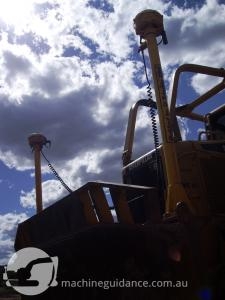
Executive Summary
The following article provides an analysis on the advantages of using machine guidance technologies for the construction of CSG gathering networks and similar projects. By using a recent project as a case study, the paper concludes that on top of the significant productivity and safety gains, a total project saving of over $4.75 million annually can be achieved by embracing machine guided construction over traditional survey methods.
This paper draws attention to the numerous benefits of machine guided construction including the ability to accurately reference project designs without the need for survey stakes, the improvement in construction accuracy due to constant design reference, the reduction of construction delays due to electronic design updates and the significant increase in workplace safety achieved by removing many of the risks associated with traditional survey stakeout tasks.
Using a recent gas gathering project as a case study the paper documents the total reduction in survey resources able to be achieved by utilising machine guided construction methods. Using the case project's historical survey field structures and proposal recommendations, it is estimated that a total of 14 survey personnel could be removed and replaced with integrated machine guidance technologies.
An analysis of the costs of this paper demonstrate that despite the significant up-front machine guidance investment of approximately $2 million, savings in traditional survey resources will allow gas gathering project to save over $4.75 million per year. This represents a total saving of over $26.5 million over the 6 year predicted lifespan of the case study project.
The demonstrated potential for massive savings in productivity and project costs are evidence of the argument for utilising machine guided construction on pipeline projects such as gas gathering. Embracing the recommended machine guided construction methodology as detailed in this proposal will assist productivity and efficiency and drive innovation in the pipeline industry.
Overview of Machine Guided Construction
Machine guided construction refers to the use of construction plant equipped with machine guidance technologies to compliment or replace traditional survey stakeouts methods.
Machine guidance involves the integration of survey positioning devices (most commonly using GPS) with construction machinery. Machine control devices use real-time position data and survey design information to instantly determine a machine's current location relative to a desired position. The difference is then displayed inside the machine cab allowing the operator to easily and efficiently determine what is required to create the intended design on the ground.
Machine guidance technologies are essentially an extension of traditional survey tools. Over time, inventions have appeared that have made a surveyor's job not only easier but much more accurate. Survey software has become more user-friendly and intuitive allowing for efficient and widespread field use, including the integration into construction machines
The basic concepts of machine guided construction are simple - use the plant that are already required for construction and equip them with survey tools that can be easily used with the existing processes. Implemented successfully, the possibilities for improved efficiency and improved productivity are significant.
Advantages of Machine Guided Construction
The following points provide a brief overview of the numerous advantages associated with replacing traditional survey with machine guided construction methods.
Pegless Construction: Providing design reference directly into the construction plant removes the need for survey staking. This reduction in survey requirements results in a significant project saving both in survey resources and construction delays.
Improved Accuracy: With constant design reference inside the machine cab, operators are able to achieve greater construction accuracy and have greater confidence in the works that they are performing.
Design Updates: The inevitability of project design changes are easily handled via electronic updates with machine guided construction, removing the delay of waiting for survey setout.
Increased Safety: Machine guided construction reduces the need for on-the-ground workers meaning there are less opportunities for potentially dangerous machine / ground-worker interactions. Reducing the need for remote front-end survey works also benefits project safety.
Cost: While the up-front cost of a machine guidance system are significant, the reduction on other project resources coupled with the construction productivity gains results in a significant overall project saving.
Read more on the advantages of machine guided construction methods here.
Traditionally Surveyed vs Machine Guided Construction
Maximum project efficiency and productivity gains are best achieved by fully embracing machine guided construction over traditional construction / survey methods. The following recommendations will allow a gas gathering pipeline project to realise these benefits in all aspects of the construction process.
Clear & Grade (C&G) Construction
- Traditional Construction:
- Survey crews mobilise ahead of construction to stake the right-of-way corridor, maintaining line-of-site between setouts and ensuring that all changes in direction are clearly represented on the ground for C&G construction crews to follow.
- Machine Guided Construction:
- C&G machinery are equipped with machine guidance providing in-cab design reference without the need for stakes. Machinery used may include bulldozers, graders and excavators. Site conditions often warrant the use of either a grader (eg grassed corridors) or dozers (timbered corridors). Wiring and configuring both machine types will allow fewer cab hardware kits to be shared amongst the machinery.
- Vehicle-mounted GPS kits are used to provide supervisor design reference including construction requirements, daily progress and required float movements.

Pipe Stringing & Welding
- Traditional Construction:
- Survey crews mobilise ahead of pipe stringing to design alignments along with any changes in the design of the pipe features.
- Construction supervisors' reference paper plans to determine pipe stringing requirements (ie number and type of pipes required).
- Machine Guided Construction:
- Construction supervisors equipped with vehicle-mounted GPS kits with constant design reference are able to easily and independently determine stringing requirements on a day-to-day basis.
Trench Excavation:
- Traditional Construction:
- Survey crews mobile ahead of construction crews and stake design pipe alignment along with other design features (changes in depth requirements, junction types, etc).
- Construction machinery such as excavators, trenchers and other pipe laying machinery use survey stakes to determine alignment and design requirements.
- Finishing construction crews (eg tie-in crews) require further survey stakeout to determine bulk construction as-built pipe locations.
- Construction supervisors' reference paper plans to determine pipe construction requirements (eg order of pipe placement, tie-in details, etc).
- Machine Guided Construction:
- Trench excavation machinery are equipped with machine guidance providing in-cab design reference without the need for stakes and reduced supervision requirements.
- Bulk construction and finishing works referencing the same design allowing for faster and more independent construction processes.
- Construction supervisors equipped with vehicle-mounted GPS kits with constant design reference are able to easily and independently determine design alignment and other critical construction design information in real-time.
Rehabilitation:
- Traditional Construction:
- Survey crews stake as-built pipe locations for placement of marker post signage.
- Survey crews collect rehabbed surface levels for determination of final as-built pipe depth of cover and as-built model creation.
- Machine Guided Construction:
- Construction supervisors equipped with vehicle-mounted GPS kits reference the location of as-built pipe to allow independent installation of marker post signage.
- Rehabilitation crew machinery (eg seeder and/or harrower tractors) equipped with machine guidance independently collect rehab surface levels for determination of final as-built pipe depth-of-cover and inclusion into the survey as-built model.
Spare
Supervision & Support:
- Traditional Construction:
- On-site design queries require survey crews to mobilise and provide representation of the project design on the ground using stakes.
- Survey crews are mobilised to stake any required design features.
- Machine Guided Construction:
- Vehicle-mounted GPS kits are used as design reference systems by engineers, managers and client-representatives. This solves any issue of providing field reference in a peg-less site thus further reducing a project's survey requirements. Supervisor systems can be relatively easily swapped between vehicles.
Additional Recommended Requirements:
- Machine Guidance Field Support:
- The introduction of any new technology comes with challenges and this is certainly true of the utilisation of survey tools by construction plant. To overcome this challenge it is recommended that the project employ the use of a number of field support surveyors who can be on-call to provide training and support.
- Machine Guidance Design Support:
- With the reliance on design reference across all construction divisions, it is recommended that additional design survey resources be utilised. Locking down the project design requirements prior to construction is another key benefit of machine guided construction.
- GPS Base Station Infrastructure:
- All real-time GPS devices (inc surveyor and machine guidance) require a direct link to a GPS base station. To facilitate the large-scale use of GPS devices on construction machinery, some additional GPS base infrastructure may be required. Survey procedures should account for the establishment of permanent GPS infrastructure at the commencement of any new works.
Reduction in Survey Requirements
Equipping construction crews with survey tools will reduce a significant number of traditional survey tasks, including:
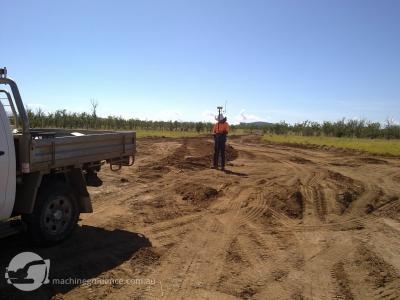
Reducing Traditional Survey Requirements 2
- Eliminate right of way corridor survey stakeout.
- Eliminate design feature survey stakeout (eg changes in pipe type and changes in design depth-of-cover).
- Eliminate construction excavation and backfill stakeouts.
- Eliminate rehab signage survey stakeout.
- Eliminate rehab surface level survey topographical pick-ups.
- Eliminate stakeout of design for supervisor on-site investigations.
Note that survey field resources will still be required for traditional tasks such as:
- Existing surface topographical survey pickups.
- Strip surface survey pickups (following C&G).
- Existing services survey pickups.
- Installed / as-built pipe survey pickups.
- Rehabbed features survey pickups (eg signage, fences, etc).
- Lease leg riser survey stakeout.
- Existing as-built processing and general construction queries.
Note that in general, utilising machine guided construction eliminates the need for time-consuming design stakeout but still requires survey resources for accurate as-built data collection and processing.
Case Study Gathering Project
Using a recent large gas gathering project as a case study provides an accurate analyse the survey resources required for traditional gathering construction methods. Similarly, incorporating the above machine guided construction recommendations on the same case study project provides an analysis on the reduction in survey requirements and costs that can be achieved by using machine guided construction methods. Note that this comparison focuses on field survey requirements but also account for an additional office surveyor who would be responsible for supporting the machines with design files (as recommended above).
The case study project selected for this analysis was constructed using four constructed groups that were geographically separated over three main areas and involved all of the above-mentioned construction phases - clear and grade, pipe stringing, trench excavation and rehabilitation. The project was manned using a 3:1 (3 weeks on, 1 week off) rolling roster. The project's potential lifespan is 6+ years.
Reduction in Survey Personnel
The case study project used three field surveyors for each construction site group along with dedicated field surveyors for each of the construction crews. A total of 31 survey personnel were employed to support the on-site construction crews. The below graph represents the survey field structure used on the case study project.
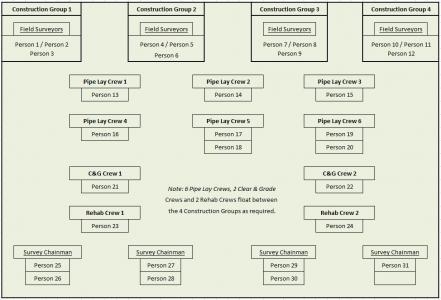
Graph 1
Graph2 text
When applying the recommendations on machine guided construction and removing the need for the traditional survey stakeout requirements the following reductions can be estimated to the case study project's survey field structure.
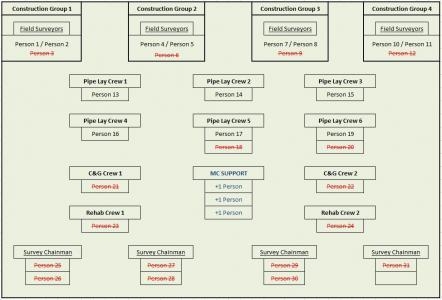
Graph02 image
Graph03text
The amended structure removes 18 traditional survey roles and adds 3 machine control support roles. The net result is a reduction of 15 survey field roles, leaving 17 field-based surveyors rather than the original 31.

Graph03 image
Cost Analysis
The approximate costs of the recommended machine guidance solutions as predicted on the case study project are calculated below:
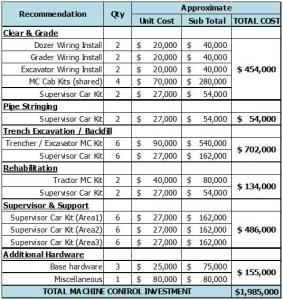
Graph04
Costs text 02
The total costs for the additional 14 traditional survey resources that the project will require without using machine guidance are calculated below.
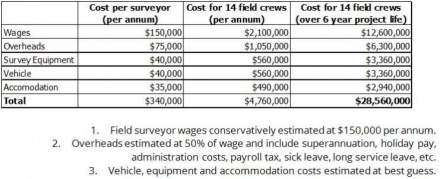
Costs text 03
As the above tables demonstrate, the estimated costs for providing traditional survey resources are estimated at $4.75 million per year. The estimated cost of machine control is $2.0 million and is a once-off investment.
The following table summarises the machine guided construction vs traditional survey cost analysis including projection over the potential 6 year project lifespan.

graph06
costs end text
Despite the significant up-front investment costs, by embracing a machine guided construction methodology the case study project have the opportunity of saving over $4.75 million in the project's survey costs per annum. This equates to a massive $26.5 million over the potential 6 year project lifespan.
Conclusion
By integrating construction machinery with survey tools, pipeline contractors can take advantage of a machine guided construction methodology with significant project benefits. Improved construction productivity, efficiency and accuracy along with increases in workplace safety alone make machine guidance technologies worthwhile investigating. The massive potential for cost savings of over $4.75 million annually make machine guided construction the most logical and exciting advancement in the pipeline industry.
Return to Articles

